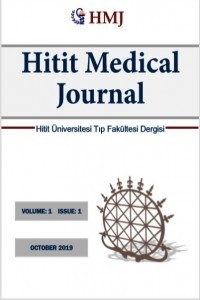KABG Sonrası Safen İnsizyon Yaralarının Primer ve Vakum Yardımlı Kapama Sonuçları
vakum aracılı kapama, safen ven, koroner arter baypas cerrahisi
Primary or Vacuum Assisted Closure For The Leg Incision Wound Infections Following CABG
___
- D.D. Wipke-Tevis, N.A. Stotts, P. Skov, V. Carrieri-Kohlman Frequency, manifestations, and correlates of impaired healing of saphenous vein harvest incisions Heart Lung, 1996;25:108-116
- P.B. L'Ecuyer, D. Murphy, J.R. Little, V.J. Fraser The epidemiology of chest and leg wound infections following cardiothoracic surgery Clin Infect Dis, 1996;22: 424-429
- Allen KB, Heimansohn DA, Robison RJ et al. Risk factors for leg wound complications following endoscopic versus traditional saphenous vein harvesting. The Heart Surgery Forum, 01 Jan 2000, 3(4):325-330
- Fleischmann W, Strecker W, Bombelli M, Kinzl L. Vacuum sealing as treatment of soft tissue damage in open fractures Unfallchirurg. 1993;96(9):488–492.
- Banwell P, Withey S, Holten I. The use of negative pressure to promote healing. Br J Plast Surg. 1998;51(1):79.
- Philbeck TE, Whittington KT, Millsap MH, Briones RB, Wight DG, Schroeder WJ. The clinical and cost effectiveness of externally applied negative pressure wound therapy in the treatment of wounds in home healthcare Medicare patients. Ostomy Wound Manage. 1999;45(11):41–50.
- Moues CM, van den Bemd GJ, Meerding WJ, Hovius SE. An economic evaluation of the use of TNP on full thickness wounds. J Wound Care. 2005;14(5):224–227.
- Atkins BZ, Wooten MK, Kistler J, Hurley K, Hughes GC, Wolfe WG. Does negative pressure wound therapy have a role in preventing post‐sternotomy wound complications? Surg Innov 2009; 16: 140– 6.
- Gulack BC, Kirkwood KA, Shi W et al Secondary surgical-site infection after coronary artery bypass grafting: A multi-institutional prospective cohort study The Journal of Thoracic and Cardiovascular Surgery 2018;155(4): 1555-1562
- Paletta CE, Huang DE, Fiore AC, Swartz MT, Rilloraza FL, Gardner JE Major leg wound complications after saphenous vein harvest for coronary revascularization The Annals of Thoracic Surgery 2000;70(2): 492-497
- Lee AJ, Sheppard CE, Kent WDT, Mewhort H, Sikdar KC, Fedak PWM Safety and efficacy of prophylactic negative pressure wound therapy following open saphenous vein harvest in cardiac surgery: a feasibility study Interactive CardioVascular and Thoracic Surgery, 2017;24(3):324–328
- Yayın Aralığı: Yılda 3 Sayı
- Başlangıç: 2019
- Yayıncı: Hitit Üniversitesi
Nadir Bir Akut Karın Sebebi Yabancı Cisme Bağlı Perforasyon
Murathan ERKENT, İbrahim Tayfun ŞAHİNER, Murat KENDİRCİ, Ramazan TOPÇU, İsmail SEZİKLİ
Cinsiyet Disforisinde Genetik Faktörlerin Rolü
Duygu ONUR CURA, Tufan ÇANKAYA, Ayfer ULGENALP
KABG Sonrası Safen İnsizyon Yaralarının Primer ve Vakum Yardımlı Kapama Sonuçları
Utku ALEMDAROĞLU, Sertan ÖZYALÇIN, İzzet HAFEZ, Emin EROL, Adnan YALÇINKAYA, Hüseyin TÜNEL, Adem İlkay DİKEN
Epitelde Atipik Skuamöz Hücreler İçeren Eritema ab igne Olgusu
Tuğba ÖZÇEREZCİ, Yılmaz BAŞ, Engin ŞENEL, Hümeyra ŞAHİN
Kolon Adenokarsinomlarinda Kras Mutasyonlarinin Sikliği Ve Lenf Nodu Metastazi İle İlişkisi
Gökhan VARLI, İbrahim Hanifi ÖZERCAN, Ebru ÖNALAN
Elif SAGSAK, Ayşegül ZENCİROĞLU
Geriatrik yaş popülasyonunun ses performansının objektif ve subjektif olarak değerlendirilmesi
